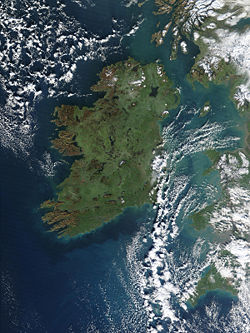Éire
2008/9 Schools Wikipedia Selection. Related subjects: Europe; European Countries

Éire (pronounced [ˈeːrʲə] pronunciation ) is the Irish name for the island of Ireland. Éire is also the Irish name for the state named Ireland.
Etymology
Éire is the nominative form in modern Irish of the name for the goddess called Ériu in Old Irish, a mythical figure who helped the Gaels conquer Ireland as described in the Book of Invasions. Comparison with ancient transcriptions of the name of the island of Ireland, and forms known from other Celtic languages, yields the Common Celtic reconstruction *φīwerjō, stem *φīwerjon-. The Celtic form implies Proto-Indo-European *piHwerjon-, likely related to the adjectival stem *piHwer- "fat" (cf. Sanskrit pīvan, f. pīvarī and by-form pīvara, "fat, full, abounding") hence meaning "fat land" or "land of abundance".
From the later Q-Celtic form *īwerjon-, in which the original p of the stem had been dropped (cf. *pater > athair "father"), was borrowed the Welsh Iwerddon "Ireland". From a similar or somewhat later form were also borrowed Greek Ἰέρνη I[w]ernē and Ἰουερνία Iouernia; the latter form was converted into Latin Hibernia. Old Irish Ériu is directly descended from *φīwerjō > Q-Celtic *īweriū. From it was borrowed Old English Íras "men of Ireland", whence Íraland "land of the Íras, Ireland".
Older explanations for the etymology of Éire, no longer considered linguistically plausible, are:
- Derived from a root word Ara (also spelt Arya, Aire or Aera) meaning noble, as in ' Aryan'. Among the very many poetic names for the island of Ireland was Mág Ealga meaning plain of the nobles.
- Ar or Ir in the Irish language also meant land, and according to old manuscripts was the name given to the lands of the mythological Celtic tribe of Gael Glas who travelled from Scythia across Greece and eventually to Ireland.
The dative form Éirinn is anglicised as Erin, which is occasionally used as a poetic name for Ireland in English, and has also become a common feminine name in English.
Difference between Éire and Erin
While Éire is simply the name for Ireland in the Irish language, and sometimes used in the English, Erin is a common poetic name for Ireland in English. The distinction between the two is one of the difference between cases of nouns in Irish. Éire is the nominative case, the case that is used for nouns that are the subject of a sentence i.e. the noun that is doing something. Erin is a Hiberno-English derivative of Éirinn, the Irish dative case of Éire i.e. a noun to which something is given, as in the phrase Éirinn Go Brách ((To) Ireland for Ever). It is very common to also see Éireann used in the titles of companies and institutions in Ireland e.g. Iarnród Éireann (Irish Rail), Dáil Éireann (Irish Parliament) or Poblacht na hÉireann (The Republic of Ireland). This is Éire in its genitive case, when it marks possession of another noun or being the most important noun in a multi-noun combination.
Éire as a state name
Article 4 of the Irish constitution adopted in 1937 provides that: "The name of the state is Éire, or, in the English language, Ireland." The Republic of Ireland Act enacted in 1948 makes clear that the "Republic of Ireland" is actually a description rather than the name of the state. Ireland (in English) and Éire (in Irish) remain its two official names. Article 8 states that both Irish and English are the official languages of the state with Irish designated as the "national" and "first official" language.
The name "Éire" has been used on Irish postage stamps since 1922; on all Irish coinage (including Irish euro coins); and together with "Ireland" on passports and other official state documents issued since 1937. "Éire" is used on the Official Seal of the President of Ireland. Before the 1937 Constitution, "Saorstát Éireann" (the Irish translation of Irish Free State), was generally used.
From 1938 to 1962 the international plate on Irish cars was marked "EIR", short for Éire. In 1922-1938 it was "SE", and from 1962 "IRL" has been adopted. Irish politician, Bernard Commons TD suggested to the Dáil in 1950 that: "with regard to the tourist identification plate bearing the letters EIR" (the) "adoption of identification letters more readily associated with this country by foreigners [would be desirable]". The amendment was effected under the Road Traffic Act 1961.
From the 1930s Irish-registered aircraft have carried a registration mark starting "EI" for Éire.
From January 2007, the Irish government nameplates at meetings of the European Union have borne both Éire and Ireland, following the adoption of Irish as a working language of the European Union.
Confusion for non-Irish speakers
The name Eire should normally be used only when speaking the Irish language, as it is simply the translation of Ireland into Irish.
- It is rarely used by the state's citizens and other residents when speaking or writing in English. Use of Eire in the English language can indicate that the speaker was brought up outside the Republic.
- Conversely, the flexibility of colloquial English is such that "Éire" can be misused by English-speakers who are intending to be polite and exact. They see it on signs and public documents and assume that, in a country where Irish is a compulsory subject in school, and where Irish is described as the "first official language" in the Irish constitution, "Éire" must be the preferred version.
Other uses
Éire has also been incorporated into the names of Irish commercial and social entities, such as " eircom plc" (formerly "Telecom Éireann") and the pop group ScaryÉire. In 2006 the Irish electricity network was devolved to EirGrid.